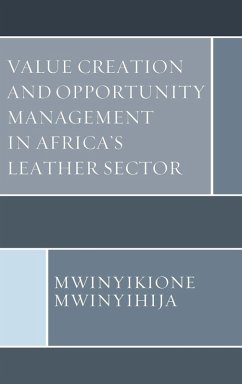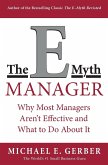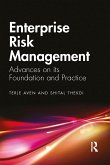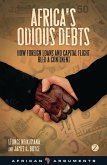Mwinyikione Mwinyihija
Value Creation and Opportunity Management in Africa's Leather Sector
Mwinyikione Mwinyihija
Value Creation and Opportunity Management in Africa's Leather Sector
- Gebundenes Buch
- Merkliste
- Auf die Merkliste
- Bewerten Bewerten
- Teilen
- Produkt teilen
- Produkterinnerung
- Produkterinnerung
This book provides unique research findings from the leather sector in African and the stratums of the value chains. The result is emerging knowledge and resourcefulness to the global community and an attestation to Africaâ s transformative trajectory from commodity dependence to product development to explore on its socio-economic opportunities.
Andere Kunden interessierten sich auch für
![The E-Myth Manager The E-Myth Manager]() Michael E. GerberThe E-Myth Manager15,99 €
Michael E. GerberThe E-Myth Manager15,99 €![Enterprise Risk Management Enterprise Risk Management]() Terje AvenEnterprise Risk Management51,99 €
Terje AvenEnterprise Risk Management51,99 €![Navigating Ambiguity Navigating Ambiguity]() Andrea SmallNavigating Ambiguity19,99 €
Andrea SmallNavigating Ambiguity19,99 €![How Remarkable Women Lead How Remarkable Women Lead]() Joanna BarshHow Remarkable Women Lead17,99 €
Joanna BarshHow Remarkable Women Lead17,99 €![The Reflective Entrepreneur The Reflective Entrepreneur]() Dimo Dimov (UK University of Bath)The Reflective Entrepreneur39,99 €
Dimo Dimov (UK University of Bath)The Reflective Entrepreneur39,99 €![Africa's Odious Debts Africa's Odious Debts]() Professor Leonce NdikumanaAfrica's Odious Debts104,99 €
Professor Leonce NdikumanaAfrica's Odious Debts104,99 €![Windows of Opportunity Windows of Opportunity]() Lord David SainsburyWindows of Opportunity26,99 €
Lord David SainsburyWindows of Opportunity26,99 €-
-
-
This book provides unique research findings from the leather sector in African and the stratums of the value chains. The result is emerging knowledge and resourcefulness to the global community and an attestation to Africaâ s transformative trajectory from commodity dependence to product development to explore on its socio-economic opportunities.
Produktdetails
- Produktdetails
- Verlag: University Press of America
- Seitenzahl: 276
- Erscheinungstermin: 31. August 2018
- Englisch
- Abmessung: 235mm x 157mm x 19mm
- Gewicht: 568g
- ISBN-13: 9780761870005
- ISBN-10: 0761870008
- Artikelnr.: 49565578
- Herstellerkennzeichnung
- Libri GmbH
- Europaallee 1
- 36244 Bad Hersfeld
- gpsr@libri.de
- Verlag: University Press of America
- Seitenzahl: 276
- Erscheinungstermin: 31. August 2018
- Englisch
- Abmessung: 235mm x 157mm x 19mm
- Gewicht: 568g
- ISBN-13: 9780761870005
- ISBN-10: 0761870008
- Artikelnr.: 49565578
- Herstellerkennzeichnung
- Libri GmbH
- Europaallee 1
- 36244 Bad Hersfeld
- gpsr@libri.de
Prof. Mwinyikione Mwinyihija, is a chartered Fellow of various acclaimed internationally recognized professional organizations where he is currently serving COMESA-Leather and Leather Products Institute (COMESA/LLPI) as Executive Director since 2013.He holds Degrees in the following fields: Ecotoxicology of the tanning Industry, Management and Remediation of Tannery Waste, Opportunity management; Value addition strategy for the leather sector; and Management Sciences. Currently, he provides leadership in the leather sector in disciplines such as Ecotoxicology and Value Chain Analysis of the leather sector and is also a mentor, reviewer, examiner, researcher, author and publisher of peer reviewed books, papers and presentations at global and regional levels.
Chapter 1: Introduction
1.1 Statement of the Problem
1.2 Importance of the Study
1.3 Research Design and Approach
1.4 Research Questions and Hypotheses
1.5 Assumptions, Limitations and Delimitations
1.5.1 Assumptions
1.5.2 Limitations
1.5.3 Delimitations
1.6 Expected Findings
1.7 Definition of Terms
1.7.1 Organization of the Study
1.8 Summary
Chapter 2: Opportunity Management and its Relevance to Leather Value
Addition
2.1 Introduction
2.1.1 Objective of the Review
2.2. Value Addition
2.2.1 Characteristics of Value Addition
2.2.2 Leather Sector Performance
2.2.3 Livestock and Raw Material
2.2.4 Leather Processing
2.2.5 Leather Goods
2.3 Value Chain Composition and Analysis
2.3.1 Value Chain Composition
2.3.2 Value Chain Analysis
2.4 Opportunity Management
2.5 Strategy for the Leather Value Chain
2.6 Revealed Gaps in the Review
2.6.1 Comprehensive Leather Value Chain Analysis
2.6.2 Opportunity Management Criteria
2.6.3 Concept Driven Strategies
Conclusion
References
Chapter 3: Emerging Leather and Leather goods Trends and Continental Shifts
3.1 Introduction
3.2 Exports Trend of Hides and Skins Worldwide
3.3. Comparative Review of Leather Processing
3.3.1 Factors of Success on Selected Countries
3.3.2 Preview of Africa's Leather Sector
3.3.3 Value Chain Performance
3.4 Leather Footwear Industry
3.4.1 Opportunities to the Leather Sector
3.5 Opportunities in Africa
3.6 Conclusion
References
Chapter 4: The Intrigues of Leather of Value Addition Initiatives in Africa
4.1 Introduction
4.1.1 Background.
4.2 Purpose of the Study
4.3 Performance Trends in the Leather Sector
4.3.1 Production patterns at Global, Africa and Selected Country Level
4.3.2 Impact to Socio-Economic Indicators
4.4. What are the Problems of the Leather Sector in Africa?
4.4.1 Kenya as an Example
4.5 Importance of Value Addition Chains
4.5.1 Complexities of the Leather Value Chain
4.5.2 Intrinsic and Extrinsic Factors of Leather Value Addition
4.6 Strategy Towards Leather Development
Conclusion
References
Chapter 5: Diagnostics and Redefined Novel Approach 'Triple Helix' Towards
Africa's Leather Development
5.1 Introduction
5.2 Methodology
5.3 Analysis and Presentation of Results
5.3.1 Gender and Age Group in Leather Strata
5.4 Discussion of Results
5.4.1 Limitations
5.5 Conclusion
References
Chapter 6: Prognosis of the Africa's Leather Sector Upheavals, Challenges
and Antidotes Related to Value Creation; A Case Study of Kenya
6.1 Introduction
6.1.1 Background
6.1.2 Purpose of the Study
6.2. Leather Sector's Role in the Economy
6.2.1 Dilemma Towards Value Addition
6.3 Roadmap Towards Vision 2030
6.3.1 Are There Any Indications of Value Addition Initiatives in the
Leather Sector?
6.3.2 Market Potential and Opportunities
6.3.3. Investment Preview
6.3.4 Challenges and Possible Interventions to the Roadmap
Conclusion
References
Chapter 7: Trade Analysis of Africa's Leather Value Chain Strata
7.1 Introduction
7.1.1 Purpose of the Study
7.1.2 Research Question and Hypothesis
7.2 Methodology
7.2.1 Sample Size
7.2.2 Sampling Procedures
7.2.3 Data Collection Methodology
7.3. Analysis and Presentation of Results
7.3.1 Trade
7.4. Discussion of Results
7.5. Conclusion
References
Chapter 8: Competitiveness as a Preamble to Value Addition related to the
Leather Sector
8.1. Introduction
8.1.1 Research Question and Hypothesis
8.2. Methodology
8.2.1 Sample Size
8.2.2 Sampling Procedures
8.2.3 Data Collection Methodology
8.3. Analysis and Presentation of Results
8.3.1 Competitiveness
8.4. Discussion of Results
8.5. Conclusion
References
Chapter 9: Productivity as a Fundamental Aspect of the Leather Value Chain
Development
9.1. Introduction
9.2. Methodology
9.2.1 Sample Size
9.2.2 Sampling Procedures
9.2.3 Data Collection Methodology
9.3. Analysis and Presentation of Results
9.3.1 Productivity
9.4 Discussion of Results
9.5 Conclusion
References
Chapter 10: Innovation as Key to Development of the Leather Value Chain
10.1 Introduction
10.2 Research Questions
10.3 Theoretical Framework
10.4 Methodology
10.5 Results
10.5.1 Technology and Research
10.6 Research and Development (R&D)
10.6.1 Innovation Towards Processing or Product Development
10.7 Discussion
10.8 Conclusion
References
Chapter 11: Conclusions and Recommendations
11.1 Summary of the Results
11.2 Discussion of the Results and Conclusions
11.3 Limitations
11.4 Implications for Theory and Research
11.5 Implications for Practice
11.6 Recommendations
11.6.1 Professional Practice/Practitioners
11.6.2 Further Research
11.7 Conclusion
References
1.1 Statement of the Problem
1.2 Importance of the Study
1.3 Research Design and Approach
1.4 Research Questions and Hypotheses
1.5 Assumptions, Limitations and Delimitations
1.5.1 Assumptions
1.5.2 Limitations
1.5.3 Delimitations
1.6 Expected Findings
1.7 Definition of Terms
1.7.1 Organization of the Study
1.8 Summary
Chapter 2: Opportunity Management and its Relevance to Leather Value
Addition
2.1 Introduction
2.1.1 Objective of the Review
2.2. Value Addition
2.2.1 Characteristics of Value Addition
2.2.2 Leather Sector Performance
2.2.3 Livestock and Raw Material
2.2.4 Leather Processing
2.2.5 Leather Goods
2.3 Value Chain Composition and Analysis
2.3.1 Value Chain Composition
2.3.2 Value Chain Analysis
2.4 Opportunity Management
2.5 Strategy for the Leather Value Chain
2.6 Revealed Gaps in the Review
2.6.1 Comprehensive Leather Value Chain Analysis
2.6.2 Opportunity Management Criteria
2.6.3 Concept Driven Strategies
Conclusion
References
Chapter 3: Emerging Leather and Leather goods Trends and Continental Shifts
3.1 Introduction
3.2 Exports Trend of Hides and Skins Worldwide
3.3. Comparative Review of Leather Processing
3.3.1 Factors of Success on Selected Countries
3.3.2 Preview of Africa's Leather Sector
3.3.3 Value Chain Performance
3.4 Leather Footwear Industry
3.4.1 Opportunities to the Leather Sector
3.5 Opportunities in Africa
3.6 Conclusion
References
Chapter 4: The Intrigues of Leather of Value Addition Initiatives in Africa
4.1 Introduction
4.1.1 Background.
4.2 Purpose of the Study
4.3 Performance Trends in the Leather Sector
4.3.1 Production patterns at Global, Africa and Selected Country Level
4.3.2 Impact to Socio-Economic Indicators
4.4. What are the Problems of the Leather Sector in Africa?
4.4.1 Kenya as an Example
4.5 Importance of Value Addition Chains
4.5.1 Complexities of the Leather Value Chain
4.5.2 Intrinsic and Extrinsic Factors of Leather Value Addition
4.6 Strategy Towards Leather Development
Conclusion
References
Chapter 5: Diagnostics and Redefined Novel Approach 'Triple Helix' Towards
Africa's Leather Development
5.1 Introduction
5.2 Methodology
5.3 Analysis and Presentation of Results
5.3.1 Gender and Age Group in Leather Strata
5.4 Discussion of Results
5.4.1 Limitations
5.5 Conclusion
References
Chapter 6: Prognosis of the Africa's Leather Sector Upheavals, Challenges
and Antidotes Related to Value Creation; A Case Study of Kenya
6.1 Introduction
6.1.1 Background
6.1.2 Purpose of the Study
6.2. Leather Sector's Role in the Economy
6.2.1 Dilemma Towards Value Addition
6.3 Roadmap Towards Vision 2030
6.3.1 Are There Any Indications of Value Addition Initiatives in the
Leather Sector?
6.3.2 Market Potential and Opportunities
6.3.3. Investment Preview
6.3.4 Challenges and Possible Interventions to the Roadmap
Conclusion
References
Chapter 7: Trade Analysis of Africa's Leather Value Chain Strata
7.1 Introduction
7.1.1 Purpose of the Study
7.1.2 Research Question and Hypothesis
7.2 Methodology
7.2.1 Sample Size
7.2.2 Sampling Procedures
7.2.3 Data Collection Methodology
7.3. Analysis and Presentation of Results
7.3.1 Trade
7.4. Discussion of Results
7.5. Conclusion
References
Chapter 8: Competitiveness as a Preamble to Value Addition related to the
Leather Sector
8.1. Introduction
8.1.1 Research Question and Hypothesis
8.2. Methodology
8.2.1 Sample Size
8.2.2 Sampling Procedures
8.2.3 Data Collection Methodology
8.3. Analysis and Presentation of Results
8.3.1 Competitiveness
8.4. Discussion of Results
8.5. Conclusion
References
Chapter 9: Productivity as a Fundamental Aspect of the Leather Value Chain
Development
9.1. Introduction
9.2. Methodology
9.2.1 Sample Size
9.2.2 Sampling Procedures
9.2.3 Data Collection Methodology
9.3. Analysis and Presentation of Results
9.3.1 Productivity
9.4 Discussion of Results
9.5 Conclusion
References
Chapter 10: Innovation as Key to Development of the Leather Value Chain
10.1 Introduction
10.2 Research Questions
10.3 Theoretical Framework
10.4 Methodology
10.5 Results
10.5.1 Technology and Research
10.6 Research and Development (R&D)
10.6.1 Innovation Towards Processing or Product Development
10.7 Discussion
10.8 Conclusion
References
Chapter 11: Conclusions and Recommendations
11.1 Summary of the Results
11.2 Discussion of the Results and Conclusions
11.3 Limitations
11.4 Implications for Theory and Research
11.5 Implications for Practice
11.6 Recommendations
11.6.1 Professional Practice/Practitioners
11.6.2 Further Research
11.7 Conclusion
References
Chapter 1: Introduction
1.1 Statement of the Problem
1.2 Importance of the Study
1.3 Research Design and Approach
1.4 Research Questions and Hypotheses
1.5 Assumptions, Limitations and Delimitations
1.5.1 Assumptions
1.5.2 Limitations
1.5.3 Delimitations
1.6 Expected Findings
1.7 Definition of Terms
1.7.1 Organization of the Study
1.8 Summary
Chapter 2: Opportunity Management and its Relevance to Leather Value
Addition
2.1 Introduction
2.1.1 Objective of the Review
2.2. Value Addition
2.2.1 Characteristics of Value Addition
2.2.2 Leather Sector Performance
2.2.3 Livestock and Raw Material
2.2.4 Leather Processing
2.2.5 Leather Goods
2.3 Value Chain Composition and Analysis
2.3.1 Value Chain Composition
2.3.2 Value Chain Analysis
2.4 Opportunity Management
2.5 Strategy for the Leather Value Chain
2.6 Revealed Gaps in the Review
2.6.1 Comprehensive Leather Value Chain Analysis
2.6.2 Opportunity Management Criteria
2.6.3 Concept Driven Strategies
Conclusion
References
Chapter 3: Emerging Leather and Leather goods Trends and Continental Shifts
3.1 Introduction
3.2 Exports Trend of Hides and Skins Worldwide
3.3. Comparative Review of Leather Processing
3.3.1 Factors of Success on Selected Countries
3.3.2 Preview of Africa's Leather Sector
3.3.3 Value Chain Performance
3.4 Leather Footwear Industry
3.4.1 Opportunities to the Leather Sector
3.5 Opportunities in Africa
3.6 Conclusion
References
Chapter 4: The Intrigues of Leather of Value Addition Initiatives in Africa
4.1 Introduction
4.1.1 Background.
4.2 Purpose of the Study
4.3 Performance Trends in the Leather Sector
4.3.1 Production patterns at Global, Africa and Selected Country Level
4.3.2 Impact to Socio-Economic Indicators
4.4. What are the Problems of the Leather Sector in Africa?
4.4.1 Kenya as an Example
4.5 Importance of Value Addition Chains
4.5.1 Complexities of the Leather Value Chain
4.5.2 Intrinsic and Extrinsic Factors of Leather Value Addition
4.6 Strategy Towards Leather Development
Conclusion
References
Chapter 5: Diagnostics and Redefined Novel Approach 'Triple Helix' Towards
Africa's Leather Development
5.1 Introduction
5.2 Methodology
5.3 Analysis and Presentation of Results
5.3.1 Gender and Age Group in Leather Strata
5.4 Discussion of Results
5.4.1 Limitations
5.5 Conclusion
References
Chapter 6: Prognosis of the Africa's Leather Sector Upheavals, Challenges
and Antidotes Related to Value Creation; A Case Study of Kenya
6.1 Introduction
6.1.1 Background
6.1.2 Purpose of the Study
6.2. Leather Sector's Role in the Economy
6.2.1 Dilemma Towards Value Addition
6.3 Roadmap Towards Vision 2030
6.3.1 Are There Any Indications of Value Addition Initiatives in the
Leather Sector?
6.3.2 Market Potential and Opportunities
6.3.3. Investment Preview
6.3.4 Challenges and Possible Interventions to the Roadmap
Conclusion
References
Chapter 7: Trade Analysis of Africa's Leather Value Chain Strata
7.1 Introduction
7.1.1 Purpose of the Study
7.1.2 Research Question and Hypothesis
7.2 Methodology
7.2.1 Sample Size
7.2.2 Sampling Procedures
7.2.3 Data Collection Methodology
7.3. Analysis and Presentation of Results
7.3.1 Trade
7.4. Discussion of Results
7.5. Conclusion
References
Chapter 8: Competitiveness as a Preamble to Value Addition related to the
Leather Sector
8.1. Introduction
8.1.1 Research Question and Hypothesis
8.2. Methodology
8.2.1 Sample Size
8.2.2 Sampling Procedures
8.2.3 Data Collection Methodology
8.3. Analysis and Presentation of Results
8.3.1 Competitiveness
8.4. Discussion of Results
8.5. Conclusion
References
Chapter 9: Productivity as a Fundamental Aspect of the Leather Value Chain
Development
9.1. Introduction
9.2. Methodology
9.2.1 Sample Size
9.2.2 Sampling Procedures
9.2.3 Data Collection Methodology
9.3. Analysis and Presentation of Results
9.3.1 Productivity
9.4 Discussion of Results
9.5 Conclusion
References
Chapter 10: Innovation as Key to Development of the Leather Value Chain
10.1 Introduction
10.2 Research Questions
10.3 Theoretical Framework
10.4 Methodology
10.5 Results
10.5.1 Technology and Research
10.6 Research and Development (R&D)
10.6.1 Innovation Towards Processing or Product Development
10.7 Discussion
10.8 Conclusion
References
Chapter 11: Conclusions and Recommendations
11.1 Summary of the Results
11.2 Discussion of the Results and Conclusions
11.3 Limitations
11.4 Implications for Theory and Research
11.5 Implications for Practice
11.6 Recommendations
11.6.1 Professional Practice/Practitioners
11.6.2 Further Research
11.7 Conclusion
References
1.1 Statement of the Problem
1.2 Importance of the Study
1.3 Research Design and Approach
1.4 Research Questions and Hypotheses
1.5 Assumptions, Limitations and Delimitations
1.5.1 Assumptions
1.5.2 Limitations
1.5.3 Delimitations
1.6 Expected Findings
1.7 Definition of Terms
1.7.1 Organization of the Study
1.8 Summary
Chapter 2: Opportunity Management and its Relevance to Leather Value
Addition
2.1 Introduction
2.1.1 Objective of the Review
2.2. Value Addition
2.2.1 Characteristics of Value Addition
2.2.2 Leather Sector Performance
2.2.3 Livestock and Raw Material
2.2.4 Leather Processing
2.2.5 Leather Goods
2.3 Value Chain Composition and Analysis
2.3.1 Value Chain Composition
2.3.2 Value Chain Analysis
2.4 Opportunity Management
2.5 Strategy for the Leather Value Chain
2.6 Revealed Gaps in the Review
2.6.1 Comprehensive Leather Value Chain Analysis
2.6.2 Opportunity Management Criteria
2.6.3 Concept Driven Strategies
Conclusion
References
Chapter 3: Emerging Leather and Leather goods Trends and Continental Shifts
3.1 Introduction
3.2 Exports Trend of Hides and Skins Worldwide
3.3. Comparative Review of Leather Processing
3.3.1 Factors of Success on Selected Countries
3.3.2 Preview of Africa's Leather Sector
3.3.3 Value Chain Performance
3.4 Leather Footwear Industry
3.4.1 Opportunities to the Leather Sector
3.5 Opportunities in Africa
3.6 Conclusion
References
Chapter 4: The Intrigues of Leather of Value Addition Initiatives in Africa
4.1 Introduction
4.1.1 Background.
4.2 Purpose of the Study
4.3 Performance Trends in the Leather Sector
4.3.1 Production patterns at Global, Africa and Selected Country Level
4.3.2 Impact to Socio-Economic Indicators
4.4. What are the Problems of the Leather Sector in Africa?
4.4.1 Kenya as an Example
4.5 Importance of Value Addition Chains
4.5.1 Complexities of the Leather Value Chain
4.5.2 Intrinsic and Extrinsic Factors of Leather Value Addition
4.6 Strategy Towards Leather Development
Conclusion
References
Chapter 5: Diagnostics and Redefined Novel Approach 'Triple Helix' Towards
Africa's Leather Development
5.1 Introduction
5.2 Methodology
5.3 Analysis and Presentation of Results
5.3.1 Gender and Age Group in Leather Strata
5.4 Discussion of Results
5.4.1 Limitations
5.5 Conclusion
References
Chapter 6: Prognosis of the Africa's Leather Sector Upheavals, Challenges
and Antidotes Related to Value Creation; A Case Study of Kenya
6.1 Introduction
6.1.1 Background
6.1.2 Purpose of the Study
6.2. Leather Sector's Role in the Economy
6.2.1 Dilemma Towards Value Addition
6.3 Roadmap Towards Vision 2030
6.3.1 Are There Any Indications of Value Addition Initiatives in the
Leather Sector?
6.3.2 Market Potential and Opportunities
6.3.3. Investment Preview
6.3.4 Challenges and Possible Interventions to the Roadmap
Conclusion
References
Chapter 7: Trade Analysis of Africa's Leather Value Chain Strata
7.1 Introduction
7.1.1 Purpose of the Study
7.1.2 Research Question and Hypothesis
7.2 Methodology
7.2.1 Sample Size
7.2.2 Sampling Procedures
7.2.3 Data Collection Methodology
7.3. Analysis and Presentation of Results
7.3.1 Trade
7.4. Discussion of Results
7.5. Conclusion
References
Chapter 8: Competitiveness as a Preamble to Value Addition related to the
Leather Sector
8.1. Introduction
8.1.1 Research Question and Hypothesis
8.2. Methodology
8.2.1 Sample Size
8.2.2 Sampling Procedures
8.2.3 Data Collection Methodology
8.3. Analysis and Presentation of Results
8.3.1 Competitiveness
8.4. Discussion of Results
8.5. Conclusion
References
Chapter 9: Productivity as a Fundamental Aspect of the Leather Value Chain
Development
9.1. Introduction
9.2. Methodology
9.2.1 Sample Size
9.2.2 Sampling Procedures
9.2.3 Data Collection Methodology
9.3. Analysis and Presentation of Results
9.3.1 Productivity
9.4 Discussion of Results
9.5 Conclusion
References
Chapter 10: Innovation as Key to Development of the Leather Value Chain
10.1 Introduction
10.2 Research Questions
10.3 Theoretical Framework
10.4 Methodology
10.5 Results
10.5.1 Technology and Research
10.6 Research and Development (R&D)
10.6.1 Innovation Towards Processing or Product Development
10.7 Discussion
10.8 Conclusion
References
Chapter 11: Conclusions and Recommendations
11.1 Summary of the Results
11.2 Discussion of the Results and Conclusions
11.3 Limitations
11.4 Implications for Theory and Research
11.5 Implications for Practice
11.6 Recommendations
11.6.1 Professional Practice/Practitioners
11.6.2 Further Research
11.7 Conclusion
References









